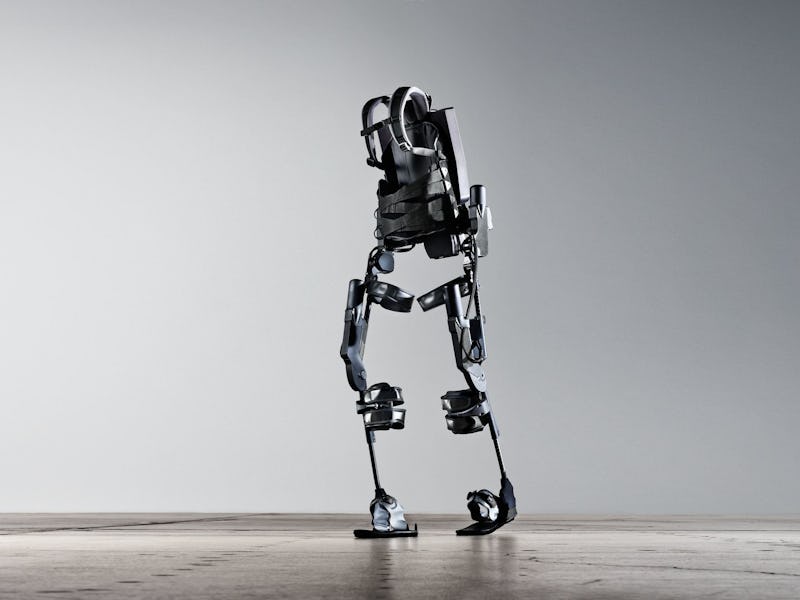The Problem with Exosuits
Exoskeletons help the most when they work against the walker.

When it comes to teaching people to walk again, the cool robotic exosuit you wear while walking a treadmill might not be as helpful as it is cool.
In some advanced facilities, it’s becoming more common for an exoskeleton to be used as people rehabilitate while walking on a treadmill. But research published this week in the journal Science Robotics has identified a major design flaw in these systems.
“If you passively move a subject [with a robot], the subject doesn’t actually learn,” Paolo Bonato, Ph.D., tells Inverse. Bonato is the author of this new research and leads a lab at the Spaulding Rehabilitation Hospital. He also studies rehabilitative medicine at Harvard University’s Wyss Institute.
As it turns out, little robotic nudges from an exoskeleton only matter if your body takes them as a disruption that might throw you off balance. So the only way that people learn from this sort of rehab is if their brains get tricked into thinking they might trip or stumble. Bonato says that this effect doesn’t need to be immediate, but the robots tricked people into detecting a long-term threat to their stability.
In this case, “the subject generated a strategy to counter the force [of the robot],” Bonato tells Inverse. He compared it to how you automatically change your stride when walking from the beach into the ocean — you don’t necessarily need to think about the adjustment.
As it turns out, these little robotic nudges only matter if your body takes them as a disruption that might throw you off balance. The only way that people learn from this sort of rehab is if their brains get tricked into thinking they might stumble.
Step Length and Step Height
The brain has an internal prediction of each step, and when that prediction is unexpectedly incorrect, it quickly tries to adjust. This works to get people to take longer steps, eventually getting them to achieve a normal stride by pushing their legs farther forward when they take steps. But current robotic rehabilitation setups don’t do much for step height. The extent to which you lift your foot during a step doesn’t mess with your center of balance nearly as much as does the length of your stride. So even when the exoskeleton pulls people’s feet higher off the ground, their actual walking patterns remain unimproved.
As robotics become increasingly common in medicine and rehabilitation, it’s important to make sure that the coolest new gadget actually helps people the way it’s supposed to. With the insight provided by these researchers, future exoskeletons and robotic tools can be designed in such a way that better helps the people relying on them to walk again.
Bonato says that the key to improving step height comes from more active participation from the rehabilitation patient. While many rehab hospitals have begun integrating video and auditory experiences for their patients while they walk on a treadmill, Bonato says that things should be taken a step further.
“It’s becoming clearer and clearer that video and auditory feedback are key to providing info and keeping the patients as active participants,” Bonato says, adding, people will better adapt their walking patterns if they integrate their rehabilitation with interactive and immersive gaming.
Abstract:
The processes underlying the generation of motor adaptation in response to mechanical perturbations during human walking have been subject to debate. We used a robotic system to apply mechanical perturbations to step length and step height over consecutive gait cycles. Specifically, we studied perturbations affecting only step length, only step height, and step length and height in combination. Both step-length and step-height perturbations disrupt normal walking patterns, but step-length perturbations have a far greater impact on locomotor stability. We found a selective process of motor adaptation in that participants failed to adapt to step-height perturbations but strongly adapted to step-length perturbations, even when these adaptations increased metabolic cost. These results indicate that motor adaptation during human walking is primarily driven by locomotor stability, and only secondarily by energy expenditure and walking pattern preservation. These findings have substantial implications for the design of protocols for robot-assisted gait rehabilitation.